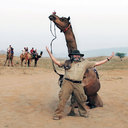0 Likes
Kroměříž is a Moravian town in the Zlin Region of the Czech Republic. The town's main landmark is the Baroque Kroměříž Bishop's Palace, where some scenes from Amadeus and Immortal Beloved were filmed. The Gardens and Castle at Kroměříž were added to the list of World Heritage Sites in 1998. The city's National Museum is home to The Flaying of Marsyas, a late painting by Titian. The town, inhabited by slavs from the 7th century, was founded in 1260 by Bruno von Schauenburg (de), bishop of Olomouc. Bruno chose Kroměříž to become his see and he also made his castle the centre of his dominion which consisted of more than 60 vassals from the whole of Moravia. Kroměříž is referred to as a market village in a document by Přemysl Otakar II from 1256, but in 1266 it is already called a town. Bruno also established what was to become the famous Archbishop's Palace. The town was badly damaged in the Thirty Years' War, was plundered twice by Swedish troops (1643 and 1645), after this the Black Death came. Bishop Karl II von Liechtenstein-Kastelkorn rebuilt the city and the palace after the war. The Constitutive Imperial Congress sat in Kroměříž in 1848.
...





The Czech Republic is a cool little landlocked country south of Germany and Poland, with a national addiction to pork and beer. Potatos, cabbage, and dumplings are close behind them, and they also have this great bar food called "utopenec." It means "a drowned man," it's pickled sausage with onions, perfect with some dark wheat bread and beer. The Czech bread is legendary, like a meal all by itself.Czechoslovakia first became a sovereign state in 1918 when it declared independence from the Austro-Hungarian Empire. The state of Czechoslovakia lasted until the "Velvet Divorce" of 1993, which created Slovakia and the Czech Republic.It was occupied by Germany in WWII but escaped major damage, unlike most other European cities. The nation's capital, Prague, retains some of Europe's most beautiful Baroque architecture as well as one of the largest medieval castle complexes still standing. The President of the Czech Republic has his offices in the Prague Castle even today.There was a coup d'etat in 1948 and Czechoslovakia fell under Soviet rule. For fifty years Czechoslovakia was a Socialist state under the USSR, subject to censorship, forced atheism and even the arrest of jazz musicians!In 1989, communist police violently squashed a pro-democracy demonstration and pissed everybody off so bad that a revolution erupted over it, finally ending the Communist rule.The next twenty years saw rapid economic growth and westernization. Today in Prague you can eat at McDonald's or KFC, shop for snowboarding boots and go see a punk rock show.The Czech Republic took over the presidency of the European Union in January 2009. This instantly created lots of political drama because the President of the Czech Republic, Vaclav Klaus, is a renowned Euroskeptic.We anxiously await the outcome of "President Klaus vs. the Lisbon Treaty", a world heavywieght fight sceduled for spring 2009.Text by Steve Smith.